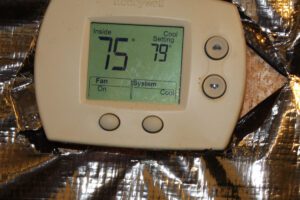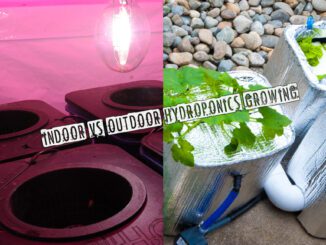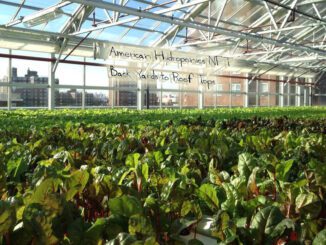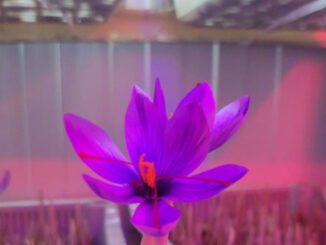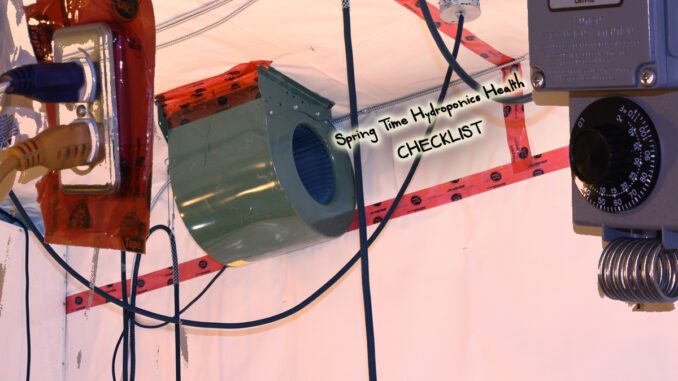
Spring Time Hydroponics Health Checklist
Before you know it, temperatures are going to begin to rise outdoors. For indoor hydroponics growers using IN/OUT active vent fans to cool year round grow rooms this may mean making some prudent changes to your gardening set up. For example, will your current ventilation system keep up-have a look at our spring time hydroponics health check list-how are you scoring?
It’s Going to Heat Up Outdoors…FAST
During cooler months the outside air was likely dry and cool, making it easy to cool grow lights with a steady flow of cooler outside air venting through and out of the growing area. If your vent system, operating at full capacity struggled to keep the lights on temperatures less than 85 Deg F during cooler months, it means you will need to make some upgrades or for seasoned growers, seasonal changes to their growing set-up. Even with a well planned IN/OUT set-up running lights during cooler nights, expect a rise of 12-15 Deg F with the lights ON.
Above: A 4 Deg F Cooling Differential with optimal lights ON growing temperature maintained.
Here are some options.
Swap-out your existing grow room cooling vent fans for a larger output (CFM) model-OR-if using inline centrifugal fans you can simply install additional fans of the same diameter and CFM into the existing duct work. This effectively doubles or triples the performance, depending on how many additional and identical fans are installed. Moving lots more air through the same diameter duct work can be nosier though. It also means installing a bigger capacity carbon filter to still be effective in trapping odors, etc.
TIP:
If you have a furnace-style shaded pole blower (squirrel cage type) fan(s) operating in your vent system, most will have THREE different operating outputs-if you are qualified, check if there are two other colour coded wires that have been capped off or are secured and un-stripped. If so, you might not be operating at 100% capacity. Consult the wiring diagram or speak to a qualified person to see if you can increase your output without changing anything other than your carbon filter by changing fan speeds.
Hot AND Sticky
During summer months, most grow rooms climate controlled with vent fans will become more humid versus winter months, with all of your growing equipment remaining equal. Excessive humidity levels, for example past 60%+ can create problems for crops like flower diseases and stretching (especially aggravated in warmer environments). Higher humidity can also seriously reduce the effectiveness of activated carbon filters. Watch for excessive humidity levels, especially during the dark cycle and install an additional de-humidifier if necessary
TIP:
Collecting condensate from clean professionally serviced and installed de-hums is a FREE source of pure living water-soil gardeners indoors even learn to tell when to water from how much water has been collected in their catchment/watering barrel. This can help to offset increased water consumption, typically via RO Filtration during warmer months when watering demands, even with indoor gardens, can increase.
With warmer weather approaching, if you are not already using an RO Filtration system to purify the water you sue to feed your crop (as most of us should be), now is a good time to buy one. If you already are using an RO filtration system, double check the condition of the filters and membranes and replace. Also note if your current Gallon Per Day collection rates will suffice with any increased demand and plan accordingly.
Remove Heat at the Source
Air-Cooled HID lamp reflectors and dimmible ballasts can mean the difference between being able to grow healthy indoor crops successfully with good yields versus having lots of troubles with little reward to show for it because the grow room could not be maintained below 85 Deg F with the lights ON. If you can maintain an optimal temperature with the lights ON for 15 minute intervals at optimal temperatures without venting the grow room air because you are using sealed air-cooled lamp reflectors, it can afford the opportunity to boss the growing environment with elevated levels of Carbon Dioxide (CO2). Using modern and energy efficient grow lights, like Induction Grow Lighting can significantly reduce cooling requirements because less heat is generated for the levels of light being produced.
TIP:
Most popular indoor hydroponics crops will perform better in warmer temperatures when they are supplied with higher than ambient CO2 levels in the growing atmosphere. Increased CO2 while the lights are on allows plants to sustain a higher ate of metabolic activity that results in a warmer climate. CO2 can also boost yields and growth rates while discouraging insect problems.
Insect Wildfires
If you have seen crop pest insects in your garden, especially Spider Mites, now is the time to completely wipe them out. Once crop pests like spider mites take hold in warmer and drier growing conditions, they can multiply at TWICE their normal rate, making them much harder to control, let alone eliminate. Same holds true for any issues your plants may have in the root zone-warmer temperatures and wet soggy roots can quickly encounter problems like root rot, seriously hurting the crop’s potential. You can avoid using any chemicals at all by using Beneficial Insects that are predatory to pests that won’t bug you either.
TIP:
If growing in a soil or organic based soilless medium like peat moss mix or coconut coir mix, watering once per week with an aerobic compost tea or including beneficial plant fungi and bacteria in your waterings can help to keep root pathogen populations from exploding into disease causing levels. Fill the biological space available for life with friendlys and you will send the bad guys packing;)
Check back soon for tips on managing warmer climates in active hydroponics systems like the Under Current efficiently with no sacrifice in crop yields or quality.

